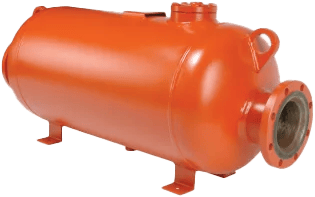Description
Smith Meter® Model AR Air Eliminator separates and releases air or gas from petroleum or other liquids before they are passed through the meter.
Complete elimination of air or gas is essential for accurate metering, making the Smith Meter® Model AR Air Eliminator a necessary part of a metering system when there is a possibility of air or gas being present in the flow stream.
Principles of Operation
The air eliminators are horizontal pressure vessels with flanged end connections.
The air eliminators operate by reducing fluid line velocity, allowing vapor bubbles to rise to the top of the vessel where they are vented through the air release head.
Applications
Air eliminators should always be installed as close to the pump and meter as possible. The air release head should be piped to a safe point of discharge.
Never pipe to the inside of a building. Provide the end of the air release pipe with a suitable flame arrestor.
The air release line should have an open drip at the lowest point, discharging back to storage or suitable container at atmospheric pressure.
A valve may be placed in the air release line near the eliminator, provided the valve is always open except in an emergency.
Features- For refined products and crude oils
- Viscosity up to 45 mPas (200 SSU) and 45 through 400 mPas (2000 SSU) with DE-2 Air Release Head
- A wide selection of tanks and Air Eliminator Heads for proper application
- Mechanical or Electrical Air Elimination Heads – RB, UB or DE Series
- Code Conformance – Tanks may be supplied in conformance with the ASME Code Section VIII or other
- Post Weld Heat Treatment (PWHT) is standard on all AR tanks. Therefore, suitable for Ethanol or Ethanol blending services
Configure
Specifications
Specifications
Brand
End Connections
- Raised Face Flanges per ASME B16.5
Maximum Working Pressure
- Class 150 RF: To 285 psig (1,965 kPa) at 100°F (38°C)
- Class 300 RF: To 300 psig (2,068 kPa) at 100°F (38°C)
Temperature Range
- Standard: Buna-N Elastomer: -20°F to 225°F (-29°C to 107°C)
- Optional: Low Swell Buna: -20°F to 225°F (-29°C to 107°C) | Viton: 0°F to 400°F (-18°C to 205°C) | Chemraz (UB Head only): -20°F to 450°F (-29°C to 232°C)
- Other Temperatures and Pressures: Consult Factory
Materials of Construction
- Inlet and Outlet Heads: SA516 GR. 70
- Shell: SA516 GR. 70
- Inlet and Outlet Pipes: SA53 or SA106 GR. B Type S
- Wells: SA53 or SA106 GR. B Type S
- Drain: A105
- Feet: A36
- Hand-Holes: SA516 GR.70
- Lifting Lugs: SA516 GR. 70
